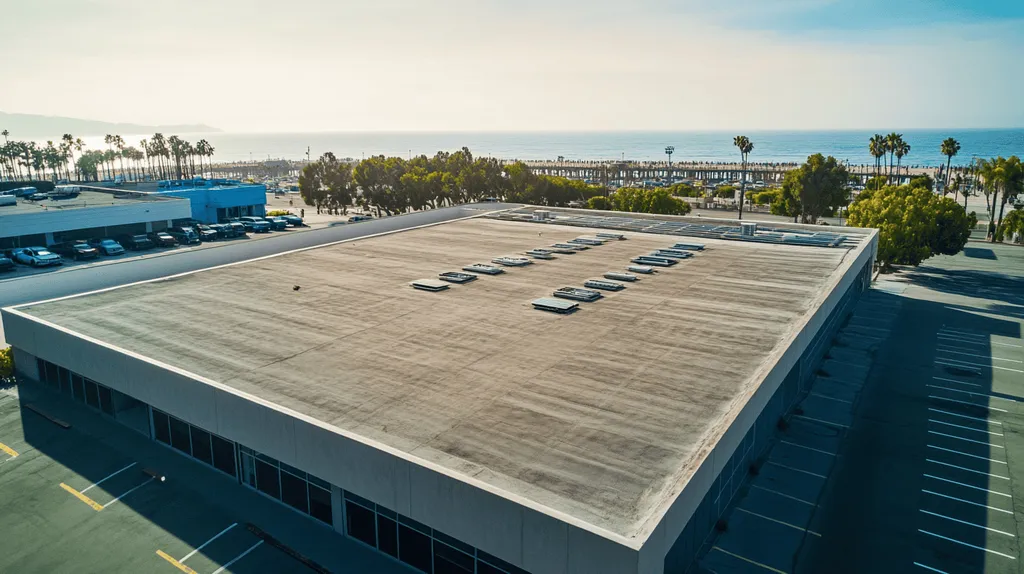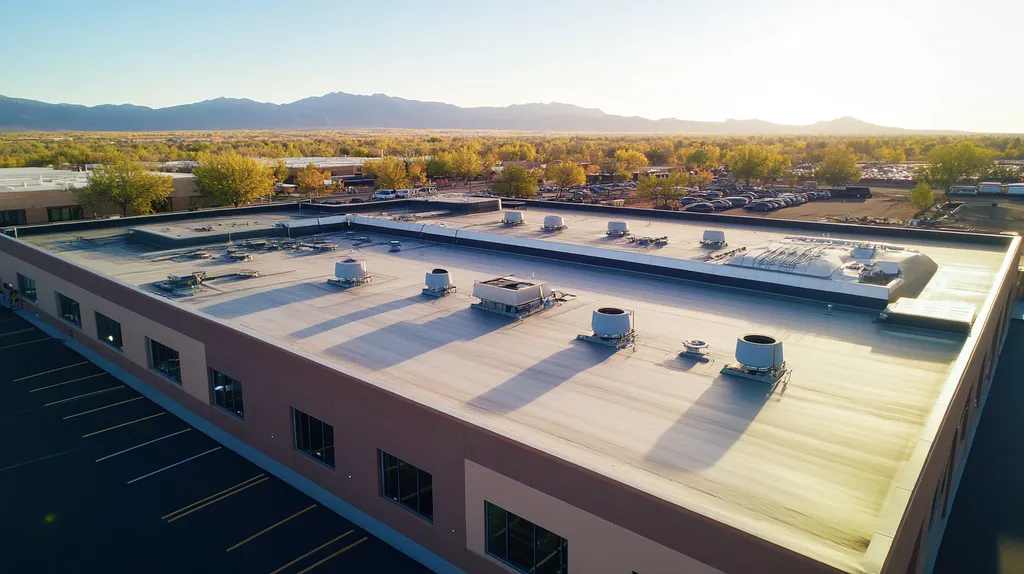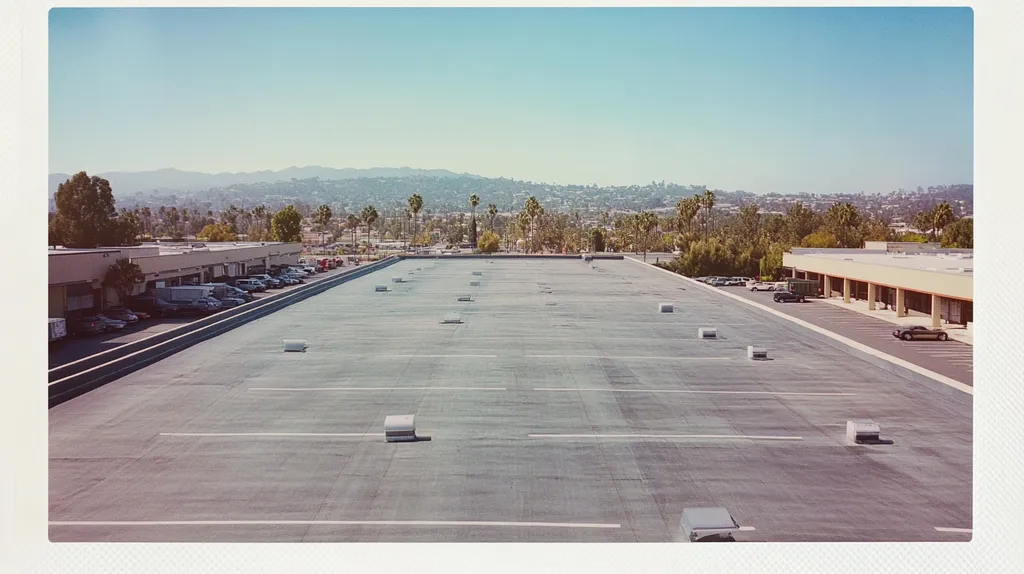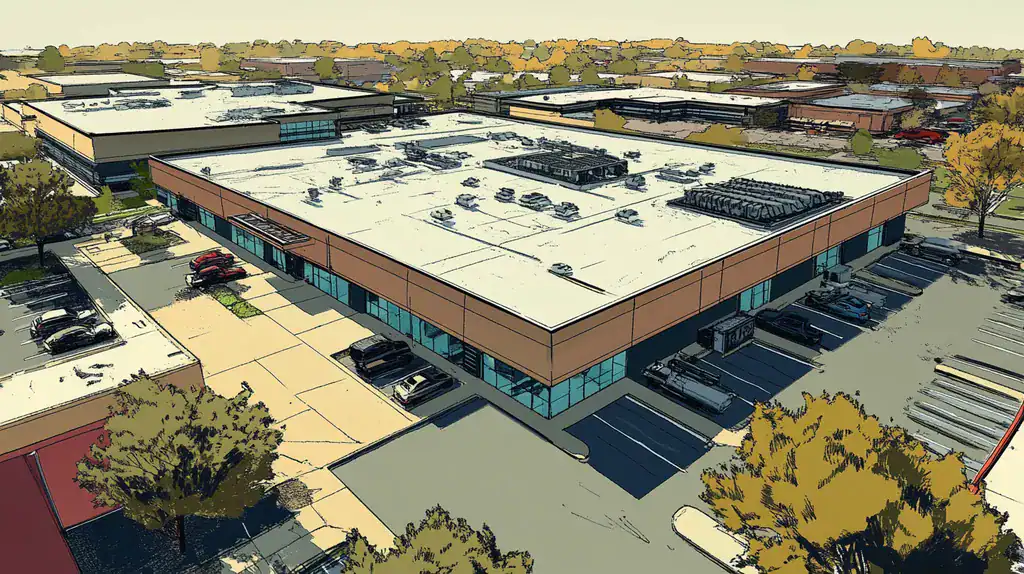Every year, commercial property owners spend over $5 billion on emergency roof repairs that could have been prevented through proper damage assessment. Studies show that 90% of catastrophic roof failures begin with minor, detectable damage that goes unchecked.
Understanding how to properly assess commercial roof damage is crucial for protecting both property investments and occupant safety. Early detection through systematic evaluation can extend a roof’s lifespan by up to 50% while preventing costly structural issues.
This comprehensive guide breaks down the essential components of roof damage assessment, from basic terminology to advanced inspection techniques, empowering property owners to make informed decisions about their roofing assets.
SECTION 1: THE BASICS EXPLAINED
Assessing damage on a commercial roof is not just a good idea—it’s essential for maintaining the overall health of a property. Studies show that nearly 90% of major roofing problems stem from unnoticed damage that builds up over time. Regular assessments can save property owners from expensive repairs down the line and extend the life of their roofs. By understanding how damage assessments work, why they are important, and how to properly implement them, building owners can significantly enhance their property’s longevity and value.
What It Is (In Plain Language)
A damage assessment on a commercial roof is a thorough inspection of the roofing materials and structure. This process looks for both visible and hidden issues, such as leaks, cracks, and general wear and tear. Inspectors often utilize tools like infrared cameras and moisture meters to identify problems that aren’t immediately obvious.
During regular inspections, professionals check for signs of deterioration, including loose or missing shingles and punctures. They also assess vital components like roof flashing and drainage systems, which help prevent water accumulation and related issues. A comprehensive assessment results in a clear picture of the roof’s current state.
An effective evaluation empowers property owners to recognize potential risks and prioritize repairs. Engaging experts for this service ensures a thorough and reliable review of a roof’s condition.
Regular damage assessments are crucial not only for identifying current issues but also for planning maintenance in advance. This proactive strategy can make all the difference in keeping a building operationally sound.
Why It Matters (To Your Building)
The health of a roof directly influences the entire structure of a building. When damage remains unnoticed, it can lead to serious consequences such as water infiltration and mold growth. These risks threaten both the integrity of the building and the safety of its occupants.
Cost implications are another vital aspect to consider. The longer damage is ignored, the more severe and expensive repairs can get. A seemingly minor leak, if left unattended, can escalate into major structural problems, leading to thousands of dollars in repair bills.
A well-maintained roof also boosts a property’s value and attractiveness in the market. Potential buyers typically want reassurance about the roof’s health during transactions. Documented assessments can serve as valuable proof of a well-cared-for investment.
Ultimately, regular damage assessments allow property owners to make informed choices, adhere to safety regulations, and protect their investments over time.
How It Works
The damage assessment process typically unfolds in several steps. First, it’s important for property owners to schedule regular inspections—ideally every six months or after extreme weather events. This creates a continuous record of the roof’s condition and helps track changes over time.
During an inspection, professionals will evaluate not just the roof surface but also areas like gutters, flashings, and even equipment such as HVAC systems. Advanced technologies may be used to detect hidden moisture beneath the surface, where issues might not yet be evident.
The results from each assessment will be compiled into a detailed report. This report outlines identified issues, prioritizes necessary repairs, and provides recommendations for future maintenance. With this information in hand, property owners can effectively budget for needed work.
Finally, acting promptly on assessment findings is crucial. Quickly addressing identified problems can minimize further damage and extend the roof’s lifespan. By prioritizing these assessments, property owners foster a proactive approach to building maintenance that benefits their entire facility.
SECTION 2: PRACTICAL APPLICATIONS
Assessing damage on a commercial roof is a crucial responsibility that significantly impacts building integrity and longevity. Studies show that neglected roof issues can account for up to 40% of premature roof failures. To safeguard their investments and ensure tenant satisfaction, property owners must be proactive about assessing roof conditions and understanding when and how to perform these evaluations.
Common Uses & Examples
Regular roof assessments play a vital role in maintaining the health of a commercial property. Many property owners schedule these evaluations during seasonal transitions or following severe weather events. For example, after heavy rainfall, inspecting for leaks or water pooling helps prevent moisture-related issues, such as mold and structural damage.
Additionally, assessments can uncover problems like punctured membranes or deteriorated seams. Tackling these issues early on can save property owners thousands in extensive repairs later. Moreover, a comprehensive assessment can be instrumental when preparing warranty claims, as documented evidence strengthens the case for coverage.
Inspection reports are valuable tools for budgeting. They provide insights into potential future costs, enabling strategic financial planning. By addressing minor repairs promptly, property owners can prevent major overhauls that disrupt operations and complicate budget forecasting.
In essence, conducting regular damage assessments equips property owners with a clear understanding of their roof’s condition, empowering them to maintain roofing health effectively.
When You Need It Most
Identifying key moments for roof assessments is essential for property owners. Statistically, about 60% of all roof failures occur within the first few years following installation. Consequently, assessments should be conducted after installation and at regular intervals. The aftermath of extreme weather events is also critical, as hidden damage can escalate into significant issues if overlooked.
Another crucial time for assessments is during property transactions. Potential buyers benefit from understanding the roofing condition, allowing them to make informed decisions. A thorough evaluation can enhance negotiating power or prepare sellers for potential buyer requests.
Furthermore, routine inspections should coincide with maintenance schedules for other roof-mounted systems, like HVAC units. Since these systems can impact the roof’s integrity, performing assessments concurrently ensures that nothing is overlooked. This alignment not only simplifies maintenance but also fosters a more holistic approach to building care.
Ultimately, knowing when to conduct roof assessments is vital for prolonging the lifespan of the roof and preserving property value.
Interactions With Other Systems
The interrelationship between roofing systems and other building components is significant. Roofs often support essential equipment like HVAC systems, and any damage in one area can adversely impact another. This interconnectedness underscores the importance of comprehensive assessments.
For instance, inadequate drainage from gutters might cause water to pool on the roof, precipitating leaks and deterioration. Regular inspections should include monitoring for debris that clogs gutters and downspouts. Taking this proactive stance can greatly extend the life of the roof.
Additionally, evaluating the roof’s relationship with insulation is crucial. A damaged roof can compromise insulation effectiveness, driving up energy costs for heating and cooling. Identifying insulation deficiencies during damage assessments can lead to significant savings on energy bills over time.
In summary, understanding how roofing interacts with other systems fosters a holistic view of a building’s health. Regular assessments reveal vulnerabilities, promote integrated maintenance, and ultimately enhance overall operational efficiency.
SECTION 3: KEY TERMINOLOGY DECODED
Grasping roofing terminology is essential for effective discussions around commercial roof assessments. Misinterpretations can lead to misguided decisions that jeopardize the roof’s integrity and inflate repair costs. By familiarizing themselves with key phrases, property owners and facility managers can identify issues quickly and act decisively. This section unpacks vital roofing terms, transforming industry jargon into straightforward language.
Essential Terms Explained
Familiar terms like “substrate,” “flashing,” and “membrane” form the backbone of roofing discussions. The substrate is essentially the foundation layer, usually made from plywood or concrete, that supports the entire roofing system. Flashing consists of thin, waterproof materials placed at joints to thwart leaks. The membrane, meanwhile, serves as the outer barrier shielding the interior from the elements. Understanding these concepts enables clearer communication with roofing professionals.
Another crucial term, “drainage,” refers to how water is directed off the roof. Well-designed drainage systems are vital for preventing water pooling, which can lead to structural damage. Property owners should prioritize roofs that have effective drainage solutions, contributing to their longevity and safety.
Finally, “low-slope” and “steep-slope” roofs are categories based on a roof’s pitch. Low-slope roofs necessitate specific materials to handle water runoff efficiently. Recognizing roof types is helpful for appreciating their maintenance requirements and vulnerabilities.
Industry Jargon Translated
At first glance, many industry terms can appear daunting, but they represent essential concepts for roof health. For instance, “R-value” indicates thermal resistance; a higher R-value means better insulation, which can reduce energy costs. Property owners should pay attention to R-values when selecting roofing materials to enhance energy efficiency.
Types of roofing membranes like “TPO” (Thermoplastic Olefin) and “PVC” (Polyvinyl Chloride) offer distinct advantages. TPO is favored for its flexibility and heat-reflective qualities, helping keep buildings cooler. On the other hand, PVC is often selected for its resilience and long lifespan, making it suitable for exposure to extreme weather.
Additionally, terms such as “ponding” and “blistering” refer to specific types of damage. Ponding describes the accumulation of water on the roof surface, while blistering signifies air bubbles trapped beneath the material. Early identification of these issues is vital for preventing more extensive damage and costly repairs.
Measurement & Units Simplified
Understanding measurements is crucial when evaluating roofing structures. The term “square” refers to a 10×10 foot area, which is a standard unit used for estimating roofing materials. It’s important for property owners to note that manufacturers typically quote materials in squares, making this knowledge key for accurate calculations.
Another significant measurement is “pitch,” which indicates the roof’s slope and influences drainage and material selection. The pitch is expressed as a ratio; for example, a roof with a 4:12 pitch rises 4 inches for every 12 inches it runs horizontally. This information impacts the type of roofing system that can be effectively employed.
Finally, understanding the dimensions of roof penetrations—like vents and HVAC units—is essential for accurate assessments. These measurements help determine how well various roofing systems can integrate additional features without affecting durability or risking leaks.
SECTION 4: DECISION FACTORS
When it comes to commercial roof damage assessments, understanding the key decision factors is vital for property owners. With roofing replacements averaging between $200,000 and $500,000, the stakes are high. Every choice made during this process can have financial implications that resonate throughout the lifespan of the property. The crucial aspects to consider include cost, performance trade-offs, and factors that influence lifespan and durability. By closely examining these considerations, property owners and facility managers can make informed decisions that protect their investments.
Cost Considerations
Cost is usually the first thing property owners think about. The prices for roofing materials can differ greatly, typically spanning from $1.50 to $6.00 per square foot. While choosing a budget-friendly option might sound attractive, it could result in higher expenses over time due to maintenance and potential replacements.
It’s essential to grasp the total cost of ownership. This encompasses not just the initial installation but also ongoing inspections, repairs, and potential replacements that may not be apparent initially. For instance, a roof that appears cheaper upfront might require frequent fixes, negating any initial savings.
Insurance premiums also play a significant role in overall costs. Quality roofing materials can help lower premiums and reduce the likelihood of filing claims over time, ultimately saving financial resources.
Moreover, it’s wise to set aside a budget for unexpected issues. Having funds available for emergency repairs or the costs associated with weather-related damage can prevent property owners from being caught off guard.
Performance Trade-offs
Performance is another crucial factor when deciding on roofing. Different materials provide various levels of energy efficiency, durability, and resistance to environmental factors. For example, single-ply membranes are renowned for their energy efficiency, but they might not outlast built-up roofing systems.
It’s important to understand that sacrificing performance for lower initial costs can backfire. A roof that underperforms can lead to increased energy bills and frequent repairs, ultimately undermining overall efficiency. Property owners should take a long-term view and consider the advantages of investing in high-performance systems.
Adaptability of roofing systems is equally critical. Flexible materials are better at withstanding changes over time, ensuring they perform effectively even as weather patterns or building codes change. Thus, performance should not be compromised for short-term savings.
In summary, evaluating performance trade-offs helps property owners focus on value while making roofing decisions. A well-thought-out assessment can lead to smarter investments that enhance the building’s overall functionality.
Lifespan & Durability Factors
The longevity of a roofing system significantly influences decision-making during assessments. Different materials boast varying life expectancies: some single-ply systems last around 15 years, while high-quality built-up roofs can exceed 50 years. Knowing these differences is key in planning for future costs.
Durability also factors heavily into lifespan. Extreme weather events—like intense heat, heavy snowfall, or strong winds—can greatly impact the roof’s longevity. For instance, a roof designed for coastal climates may struggle in areas prone to heavy snow unless it’s engineered accordingly.
Regular maintenance is essential for maximizing a roof’s lifespan. Routine inspections and minor repairs can prevent small issues from escalating into major problems. Establishing a proactive maintenance schedule helps in preserving the roof’s durability over time.
Ultimately, understanding the connection between lifespan, durability, and cost is critical. Investing in a more durable roofing system may necessitate a higher initial investment, but it can lead to significant cost savings in repairs and replacements over the long haul.
SECTION 5: COMMON CHALLENGES
For property owners and facility managers, understanding the common challenges of commercial roofing is critical. Ignoring these challenges can lead to substantial financial losses, from soaring energy costs to pricey repairs. Reports indicate that nearly 50% of commercial roof failures are linked to insufficient inspections and maintenance practices. This section explores common problems, important warning signs, and preventative strategies that can help protect roofing investments.
Frequent Problems & Solutions
Water pooling, membrane blisters, and premature wear are among the most frequent issues faced by commercial roofs. Water pooling often results from inadequate drainage, leading to leaks and structural damage. To tackle this, property owners should enhance drainage systems and ensure that roof slopes are correctly designed for water runoff.
Another common issue is membrane blisters, particularly in older roofs. These blisters, formed by moisture trapped beneath the membrane, can weaken the structure over time. Early detection and repair of these blisters can significantly extend the roof’s lifespan.
Granule loss on asphalt roofs is another frequent concern, which heightens vulnerability to UV rays. To combat these challenges, property owners should perform regular inspections and engage in timely repairs to maintain the roof’s integrity.
Establishing a proactive maintenance plan is essential. Regular inspections and prompt repairs can prevent these issues from escalating, ensuring long-term roof durability.
Warning Signs To Watch For
Monitoring the condition of a commercial roof requires vigilance. Property owners should be on the lookout for visible signs like discoloration, cracks, or rust. Discoloration on a membrane could signify premature aging or water infiltration, warranting immediate attention.
The growth of algae or moss is another critical warning sign. These organisms can retain moisture, promoting further deterioration. Observing these growths should prompt immediate inspections to address potential moisture problems.
Interior indicators, such as water stains on ceilings, are red flags for underlying roofing issues. Property managers must act quickly to resolve these signs before they evolve into significant leaks.
Routine visual inspections, alongside advanced technologies like infrared scans, can be instrumental in uncovering hidden problems before they become apparent.
Preventative Approaches
Creating a robust preventative maintenance program is essential for prolonging the life of a commercial roof. Regular inspections, ideally twice a year and after severe weather events, can catch issues early. Always use qualified roofing professionals for thorough assessments to ensure accurate evaluations.
Regular debris removal from the roof surface is a simple yet essential maintenance task. Clogged gutters and drains can lead to water accumulation, resulting in severe damage over time. Keeping these areas clear mitigates many common issues.
Investing in high-quality roofing materials can also pay off in the long run. While the initial costs may be higher, durable options can lead to savings through lower repair and energy costs over time.
Finally, establishing an effective communication channel between property management, facilities teams, and roofing contractors fosters an informed approach to maintenance. A knowledgeable team is better equipped to respond swiftly to emerging challenges.
SECTION 6: NEXT STEPS & RESOURCES
Understanding the implications of roof damage is critical for commercial property owners. Timely assessments not only help in maintaining the integrity of the roof but can also prevent costly repairs later on. Research shows that proactive roof maintenance can lower long-term expenses by as much as 30%. By knowing which questions to pose, what industry standards to follow, and how to further their roofing education, property owners can effectively manage their roofing health and investment.
Questions To Ask Providers
Choosing the right roofing provider for damage assessments begins with asking insightful questions. First, inquire about their experience specific to commercial roofs. A reputable provider will have a solid track record relevant to your building type.
Next, delve into their inspection process. What specific techniques and tools do they employ? Understanding their approach gives insight into the thoroughness and effectiveness of their assessments.
Additionally, ask about their use of advanced technologies, such as drones or thermal imaging. These tools help in revealing potential issues that may not be visible during a standard visual inspection.
Lastly, it’s essential to discuss the timeline for repairs once damage is identified. A swift response can help minimize further deterioration and safeguard your valuable investment.
Industry Standards & Guidelines
Familiarizing yourself with industry standards is vital for making informed roofing decisions. The American Society for Testing and Materials (ASTM) publishes guidelines that clarify acceptable inspection protocols and material performance standards, ensuring assessments are comprehensive and reliable.
The National Roofing Contractors Association (NRCA) also provides invaluable resources for property owners. Their guidelines support an understanding of maintenance and repair best practices, making sure you stay ahead of potential issues.
Furthermore, awareness of local regulations is key to ensuring compliance. Many states implement specific roofing codes that dictate maintenance schedules and safety protocols to follow.
Lastly, property owners should consider certifications from major manufacturers. Working with certified contractors often means adhering to higher standards and achieving better project outcomes.
Further Learning Simplified
Continued education is essential for property owners keen on enhancing their roofing knowledge. Numerous online resources offer webinars, articles, and videos on roof maintenance and assessment. Websites like Roofing Contractor and Professional Roofing provide the latest insights into industry trends.
Networking with peers offers additional benefits. Joining local or national roofing associations allows property owners to exchange experiences and gain valuable insights from industry colleagues.
Moreover, attending industry conferences can be a game changer. These events introduce new technologies and solutions while fostering connections with experts and peers.
Finally, many roofing supply companies conduct educational workshops. Engaging with these resources ensures property owners remain informed and proactive when it comes to their roofing health.
The Bottom Line
With over $5 billion spent annually on preventable commercial roof repairs, the importance of proper damage assessment cannot be overstated.
Regular, professional evaluations can extend a roof’s lifespan by up to 50% while preventing catastrophic failures that often begin as minor, detectable issues.
Understanding and implementing proper assessment protocols represents the difference between proactive maintenance and reactive emergency repairs that can cost 3-5 times more.
By following industry guidelines, working with qualified professionals, and maintaining detailed documentation, property owners can protect their investment while ensuring occupant safety and building integrity.
The future of commercial roofing lies in combining traditional inspection methods with emerging technologies, creating comprehensive assessment strategies that catch problems before they escalate into major failures.
FREQUENTLY ASKED QUESTIONS
Q. What is a commercial roof damage assessment?
A. A damage assessment involves inspecting the roof for visible and hidden issues. This includes detecting leaks, cracks, and general wear. Regular assessments help property owners understand their roof’s condition and prioritize necessary repairs.
Q. When should I assess my commercial roof?
A. It’s best to assess your roof every six months or after extreme weather. Additional checks during seasonal transitions or before property transactions are also crucial for maintaining roof health.
Q. What are common problems found in commercial roofs?
A. Common problems include water pooling, membrane blisters, and granule loss. These issues can lead to leaks and structural damage if not addressed promptly and regularly to ensure durability.
Q. What should I include in my roof maintenance plan?
A. Your maintenance plan should include regular inspections, timely repairs, and debris removal. Additionally, ensure clear communication with roofing professionals to stay ahead of potential issues.
Q. How do roofing systems relate to energy efficiency?
A. Roofing systems impact energy costs based on insulation and materials. High-performance roofs can improve energy efficiency and lower utility bills through better thermal resistance and durability.
Q. What resources can help me with roof assessments?
A. Seek resources from the National Roofing Contractors Association and American Society for Testing and Materials. Online articles, webinars, and networking with peers also offer valuable roofing insights.
Q. What should I ask during a commercial roof assessment?
A. Ask about the provider’s experience with commercial roofs, their inspection processes, and technologies used. Understanding the timeline for repairs after damage identification is also essential to protect your investment.











